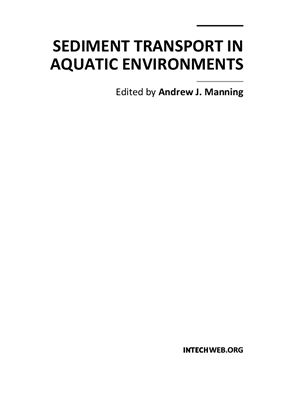InTech. 2011. 344 p.
Sediment Transport in Aquatic Environments is a book which covers a wide range of topics. The effective management of many aquatic environments, requires a detailed understanding of sediment dynamics. This has both environmental and economic implications, especially where there is any anthropogenic involvement. Numerical models are often the tool used for predicting the transport and fate of sediment movement in these situations, as they can estimate the various spatial and temporal fluxes. However, the physical sedimentary processes can vary quite considerably depending upon whether the local sediments are fully cohesive, non-cohesive, or a mixture of both types. For this reason for more than half a century, scientists, engineers, hydrologists and mathematicians have all been continuing to conduct research into the many aspects which influence sediment transport. These issues range from processes such as erosion and deposition to how sediment process observations can be applied in sediment transport modeling frameworks. This book reports the findings from recent research in applied sediment transport which has been conducted in a wide range of aquatic environments. The research was carried out by researchers who specialize in the transport of sediments and related issues. I highly recommend this textbook to both scientists and engineers who deal with sediment transport issues.
Contents.
Preface.
Part 1 Sediment Transport Issues.
Sediment Transport Pattes in Todos Santos Bay, Baja Califoia, Mexico, Inferred from Grain-Size Trends.
Dynamics of Sediments Exchange and Transport in the Bay of Cadiz and the Adjacent Continental Shelf (SW - Spain).
The Significance of Suspended Sediment Transport Determination on the Amazonian Hydrological Scenario.
Sediment Transport in Rainwater Tanks and Implications for Water Quality.
Fine Sediment Deposition at Forest Road Crossings: An Overview and Effective Monitoring Protocol.
Part 2 Numerical Modelling of Sediment Transport.
The Filling Dynamics of an Estuary: From the Process to the Modelling.
Transport of Sediments in Water Bodies of the Gulf of Califoia.
Sediment Transport Modelling and Morphological Trends at a Tidal Inlet.
Coupling Watershed Erosion Model with Instream Hydrodynamic-Sediment Transport Model: An Example of Middle Rio Grande.
Coastal Morphological Modeling.
Part 3 River, Delta and Lake Sediment Processes.
Computation of Lake or Reservoir Sedimentation in Terms of Soil Erosion.
Hydrodynamic Influences on Fluid Mud Distribution in the Amazon Subaqueous Delta.
Hydrodynamic Effects of Sedimentation on Mass Transport Properties in Dead Water Zone of Natural Rivers.
Sediment Transport and River Channel Dynamics in Romania – Variability and Control Factors.
Integrating River Bed Dynamics to Flood Risk Assessment.
Sediment Transport in Aquatic Environments is a book which covers a wide range of topics. The effective management of many aquatic environments, requires a detailed understanding of sediment dynamics. This has both environmental and economic implications, especially where there is any anthropogenic involvement. Numerical models are often the tool used for predicting the transport and fate of sediment movement in these situations, as they can estimate the various spatial and temporal fluxes. However, the physical sedimentary processes can vary quite considerably depending upon whether the local sediments are fully cohesive, non-cohesive, or a mixture of both types. For this reason for more than half a century, scientists, engineers, hydrologists and mathematicians have all been continuing to conduct research into the many aspects which influence sediment transport. These issues range from processes such as erosion and deposition to how sediment process observations can be applied in sediment transport modeling frameworks. This book reports the findings from recent research in applied sediment transport which has been conducted in a wide range of aquatic environments. The research was carried out by researchers who specialize in the transport of sediments and related issues. I highly recommend this textbook to both scientists and engineers who deal with sediment transport issues.
Contents.
Preface.
Part 1 Sediment Transport Issues.
Sediment Transport Pattes in Todos Santos Bay, Baja Califoia, Mexico, Inferred from Grain-Size Trends.
Dynamics of Sediments Exchange and Transport in the Bay of Cadiz and the Adjacent Continental Shelf (SW - Spain).
The Significance of Suspended Sediment Transport Determination on the Amazonian Hydrological Scenario.
Sediment Transport in Rainwater Tanks and Implications for Water Quality.
Fine Sediment Deposition at Forest Road Crossings: An Overview and Effective Monitoring Protocol.
Part 2 Numerical Modelling of Sediment Transport.
The Filling Dynamics of an Estuary: From the Process to the Modelling.
Transport of Sediments in Water Bodies of the Gulf of Califoia.
Sediment Transport Modelling and Morphological Trends at a Tidal Inlet.
Coupling Watershed Erosion Model with Instream Hydrodynamic-Sediment Transport Model: An Example of Middle Rio Grande.
Coastal Morphological Modeling.
Part 3 River, Delta and Lake Sediment Processes.
Computation of Lake or Reservoir Sedimentation in Terms of Soil Erosion.
Hydrodynamic Influences on Fluid Mud Distribution in the Amazon Subaqueous Delta.
Hydrodynamic Effects of Sedimentation on Mass Transport Properties in Dead Water Zone of Natural Rivers.
Sediment Transport and River Channel Dynamics in Romania – Variability and Control Factors.
Integrating River Bed Dynamics to Flood Risk Assessment.

